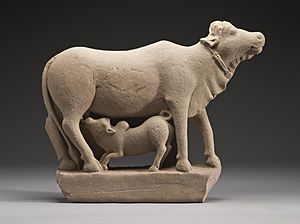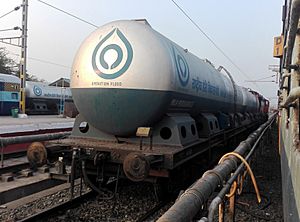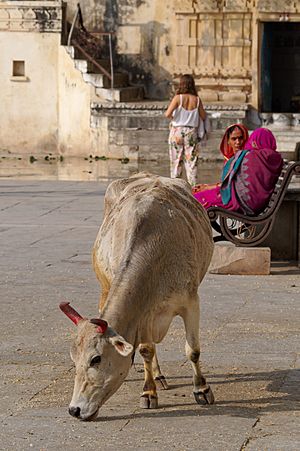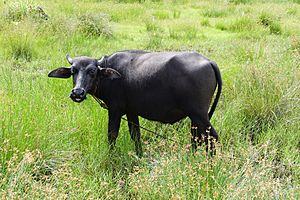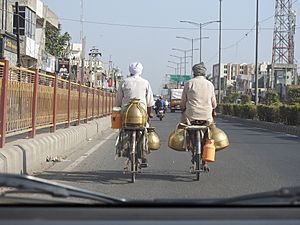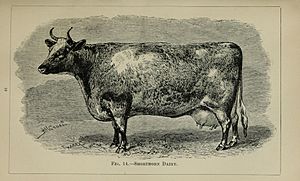Dairy in India facts for kids
Dairy products are a big part of life in India. They are used in many ways, like in food, religion, culture, and the economy.
India has the most dairy animals in the world, with over 300 million cows and buffaloes. They produce more than 187 million tonnes of milk! India is number one in the world for both making and using milk. Most of this milk is used by people in India, but a small amount is also sent to other countries.
Indian food, especially in North India, uses many dairy products like paneer (a type of cheese). South Indian food uses more yogurts and milk. Milk and dairy products are also important in Hindu religious stories and practices.
People in India have been using dairy for a very long time, about 8,000 years! This started when zebu cattle were first tamed. Milk and dairy products have been eaten in India since at least the Vedic period (an ancient time). Later, in the 1900s, a big project called Operation Flood helped India become the world's largest milk producer. Before that, most milk was produced on small family farms.
The dairy industry is very important for India's economy. Most of the milk comes from buffaloes, with cow milk being a close second. Goat milk is also produced, but much less. India makes many different kinds of dairy products. India imports (buys from other countries) very little dairy, and there are rules about it. Government groups like the National Dairy Development Board help manage the dairy industry.
Contents
History of Dairy in India
Ancient Times
Dairy farming in India began about 8,000 years ago. This was when zebu cattle, which are a type of cow, were first tamed in India. By the time of the Indus Valley Civilisation (around 3300 to 1300 BCE), zebu cattle were fully tamed. People used them for their milk. We know this because their bones and pottery from that time show they were important.
Water buffaloes also come from South Asia. They were tamed and used for farming and milk during the Indus Valley Civilisation too. Goats and sheep were also tamed, but we are not sure if they were milked back then.
During the Vedic period (around 1500 to 500 BCE), milk was a main part of people's diets. People ate milk and milk products like clarified butter (called ghee). The ancient texts called the Vedas talk a lot about milk and cows. They mention cows over 700 times and say they should not be harmed.
Yogurt (called curd) was another way people ate milk. The Vedas describe how to make curd by adding a little sour milk to fresh milk. They also mention using plants to curdle milk, which might have been an early way of making cheese.
Modern Dairy Farming
For a long time, dairy farming in India was mostly for families to produce milk for themselves. In 1919, the British rulers counted dairy animals for the first time. A report in 1937 said that people in India didn't drink much milk. They drank the least amount compared to other big dairy countries. This was because dairy animals didn't produce much milk, and many people were poor.
In the 1920s, new ways to process and sell milk came to India. The National Dairy Development Board (NDDB) was started in 1965. It launched a big program called Operation Flood in 1969–70. This program wanted to make the dairy industry modern and strong by using co-operative groups.
These co-operatives were very successful. They were based on the "Anand model," which had three levels:
- Village groups of milk producers.
- District groups that collected and processed milk.
- State groups that sold the milk.
This model started in a town called Anand in 1946 and was used all over India. Operation Flood happened in three stages, helping to develop dairy production in many cities and towns across the country. The World Bank and the European Economic Community also helped fund it.
Since 1997, India has been the world's largest milk producer, even more than the United States.
Dairy in Indian Culture
Delicious Indian Food
| How it's Made | What it is |
|---|---|
| Milk is fermented | Dahi (yogurt), shrikhand, lassi |
| Milk is curdled and pressed | Chhena, paneer, whey |
| Milk is heated until thick | Kheer, khoa, rabri, malai |
| Thickened milk is frozen | Kulfi |
Dairy has always been a key part of Indian cuisine. Foods from North India often use a lot of dairy. For example, Punjabi cuisine is known for using paneer, which is a fresh cheese. Dishes like dal makhani are rich stews made with lentils, butter, and cream. Popular paneer dishes include mattar paneer (paneer with peas) and palak paneer (paneer with spinach). Paneer is also used in snacks like paneer pakora (fried paneer) and paneer paratha (flatbread stuffed with paneer).
Ghee, which is a type of clarified butter, is used a lot in Indian cooking. It's used with rice dishes like biryani and spread on breads like roti. It has a strong flavor and is also used for cooking. Cream is often added to North Indian dishes to make sauces rich and creamy.
Another common use for milk is in tea, called chai. Most tea in India is sweet milk tea. Drinking tea became very popular in India during the 1900s.
Religion and Dairy
Cows are considered sacred in Hinduism, which is the main religion in India. However, almost half of the milk in India comes from buffaloes. In Hindu stories, the water buffalo is sometimes seen as unclean. The Hindu god of Death, Yama, rides on a water buffalo.
In ancient Indian stories about the universe, people believed that the Earth's continents were surrounded by different dairy products, like milk and ghee.
Over time, Hindu practices changed from sacrificing cows to protecting them for their milk. Milk, curd, and ghee were three of the five sacred cow products for Hindus.
Milk is offered to gods during many Hindu festivals. For example, during Pongal, rice is boiled in milk until it overflows. This is offered to the gods, then to cows, and finally to family members. During Holi, milk is used to make thandai, a special drink.
In Buddhism, there was some debate about whether drinking milk was right. Some thought it took away food from calves. But this idea was later not followed.
Jainism has very strong beliefs about ahiṃsā (non-violence) and vegetarianism. However, most Jains still eat dairy products. They believe that dairy can be made without harming animals. But in modern dairy farming, animals can still face distress. Because of this, some Jains are now choosing to be vegan.
Traditional Medicine
Milk is also used in Ayurveda, a traditional Indian medicine system. Ayurveda suggests drinking milk daily because it is believed to be good for digestion and can help you relax.
How Milk is Produced
Where India's Milk Comes From (2017–18) Local buffalo (35%) Other buffalo (14%) Goat (4%) Other cows (10%) Local cows (10%) Mixed-breed cows (26%) Foreign cows (1%)
India makes and uses more milk than any other country. In 2018, India produced 186 million tonnes of milk.
Around 2020, about 4.2% of India's total economic output came from dairy farming. The dairy sector in India was growing by almost 5% each year. In 2018–19, India produced 187.7 million tonnes of milk. This meant that each person in India had about 394 grams of milk available per day.
In 2019, India had over 300 million cows and buffaloes. Almost half of the milk in India comes from water buffaloes. Buffaloes used to produce most of the milk, but now cows are catching up. Goat milk is the third most produced type of milk, making up about 4% of the total.
The number of local Indian cow breeds has been going down. Meanwhile, the number of foreign and mixed-breed cows, which produce more milk, has been increasing. Local cows produce about 3.73 kg of milk per day. Mixed-breed cows produce about 7.61 kg per day, and foreign cows produce about 11.48 kg per day. Some experts say that milk from local cows has more nutrients.
Today, India produces almost all the milk it needs. Before India became independent in 1947, milk production was mostly done by families. Milk production in India grew three times between 1968 and 2001.
Most of India's 75 million rural dairy farms are small, family-owned farms with 10 or fewer animals.
Why Water Buffaloes are Used
India's dairy industry is special because it uses a lot of buffalo milk. Until 2013, buffaloes produced more than half of all the milk in India. Now, it's a bit less than half because people want more cow milk. The Murrah buffalo is the most popular type of dairy buffalo.
Dairy farmers in many states prefer buffaloes. This is because it's hard to sell old cows for meat due to their sacred status. But water buffaloes can be sold for meat once they stop producing milk. Also, buffaloes can digest low-quality food better than cows. Raising buffaloes is also cheaper than raising cows. They also produce more milk than local cow breeds.
Some farmers like buffalo milk because it has more fat. Milk prices are often based on fat content. Buffalo milk has about 7–7.5% fat, which is almost double that of cow milk. Many traditional Indian dairy products are made with buffalo milk because of its high fat. For example, paneer is often made with buffalo milk.
Improving Cattle Breeds
India started mixing different cattle breeds in 1875 to get more milk. Since 1965, local cows have been bred with foreign cows to increase milk production. This has helped a lot.
New breeds like Jersind and Sunandini were created. Studies showed that these mixed-breed cows produced more milk and were better at turning food into milk. They also got pregnant more often and had longer periods of producing milk.
How Milk is Processed
Packaged Milk
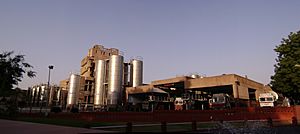
About 25% of all milk produced in India is processed by companies. About 70% of this is sold as packaged milk. The rest is used to make other dairy products. Packaged milk is usually pasteurized (heated to kill germs). It's often a mix of cow and buffalo milk.
Packaged milk is sold with different fat levels:
| Type of Milk | % Fat | % Solids (not fat) |
|---|---|---|
| Full cream milk | 6% | 9% |
| Standard milk | 4.5% | 8.5% |
| Toned milk | 3.0% | 8.5% |
| Double toned milk | 1.5% | 9% |
| Skimmed milk | 0.5% | 8.7% |
Dairy Products
India makes many different dairy products. The Bengal region has been famous for its milk-based desserts since the 1600s.
Many products are made by fermenting milk, like dahi (yogurt), shrikhand, and lassi. About 7–9% of all milk is used to make dahi. Dahi is mostly made at home, but also in factories. Shrikhand is a sweet, thick dahi, popular in western India. Mishti doi is another sweet dahi from eastern India. Lassi is a sweet buttermilk drink, popular in North India.
Other products like paneer and chhena are made by curdling milk. Paneer is made by adding something acidic to hot milk, then pressing and draining it. Paneer is very popular and about 5% of all milk is used to make it. Chhena is similar to paneer but softer. It's used to make many Indian sweets like rasgulla and sandesh.
How Much Milk is Used
People in different parts of India drink different amounts of milk. People in northwest India drink a lot of milk, while those in the northeast drink less. In areas where people eat less meat and eggs, they tend to drink more milk. This is because dairy products are a good source of protein for vegetarians. As people earn more money, they tend to drink more milk.
In 2011–12, people in villages drank about 4.333 liters of milk per month. People in cities drank about 5.422 liters per month.
In 2018, people were expected to drink 67.7 million tonnes of liquid milk. This amount was growing by 6–7 million tonnes each year. Ghee is the most popular dairy product that has extra value added to it. People are also buying more packaged milk from companies. This is probably because they think it's safer than milk from smaller, local sellers.
Rules and Safety
Keeping Animals and Milk Safe
The main group that makes rules for dairy farming is the Department of Animal Husbandry and Dairying (DAH&D). This department helps develop the dairy industry. It also manages the National Dairy Development Board (NDDB), which helps fund and grow the dairy industry. Since 2014, November 26th, the birthday of Verghese Kurien (who helped start Operation Flood), is celebrated as National Milk Day.
The Veterinary Council of India checks the health of dairy animals. They make rules for checking cattle and stopping diseases. Animals in the dairy industry are also protected by the Prevention of Cruelty to Animals Act. This act has rules about milking, breeding, and transporting cattle. In many Indian states, it's against the law to kill dairy cattle, especially cows.
There's also a rule called the Milk and Milk Products Order (MMPO). If someone handles more than 10,000 liters of milk, they have to register with the government.
Checking for Fake Milk and Safety
Sometimes, "synthetic milk" is sold. This is a mix of chemicals like detergent powder, oil, fat, salt, and water. It looks like real milk but is much cheaper to make. Also, ghee and sweets are sometimes mixed with animal fats. This often happens during festivals when more sweets are needed. The highest court in India has even suggested life imprisonment for people who fake milk.
The Food Safety and Standards Authority of India (FSSAI) checks dairy products to make sure they are safe to eat. In 2019, a survey by FSSAI found that 93% of milk samples were safe. But almost 41% of samples didn't meet all safety rules. The main problem was contamination (things getting into the milk that shouldn't be there), not just faking it. Things like mold toxins and antibiotics were found in some samples.
Dairy Farming and the Environment
In 2020, a court told the Central Pollution Control Board to make rules for dairy farms. These rules would help check how dairy farming affects the environment. They look at things like how much water is used, how animal waste is handled, and how much methane gas (a greenhouse gas) is released by dairy animals. The new rules say that dairies must be a certain distance from homes and roads. They also need licenses and regular checks on their environmental impact.
Selling Milk to Other Countries
Imports (Buying from Other Countries)
India has taxes on imported milk products like milk powder, butter, cheese, and yogurt. Whey and cheese are the biggest imports. India has been discussing whether to lower these taxes with other countries.
In 2011, India banned importing cheese that used animal rennet (an enzyme from animal stomachs). Importing animal rennet itself has been banned since 1984.
In 2020, some people wanted to allow milk powder imports without taxes. But Indian dairy farmers, like Amul, protested. They said it would harm milk production in India.
Because of religious reasons, most dairy products imported into India need a special certificate. This certificate says that the animals were not fed food made from other animals. This means many dairy products from the U.S. cannot be imported into India.
Since 2008, India has banned milk and milk products from China. This was because a harmful substance called melamine was found in Chinese milk.
Exports (Selling to Other Countries)
In 2019–20, India sent out about 51,421 metric tonnes of dairy products to other countries. This was worth about US$186.71 million. The main countries that bought Indian dairy were the United Arab Emirates, Bhutan, Turkey, Egypt, and the United States. India doesn't export much dairy because most of its milk is used at home, and global prices are not very competitive.
|


